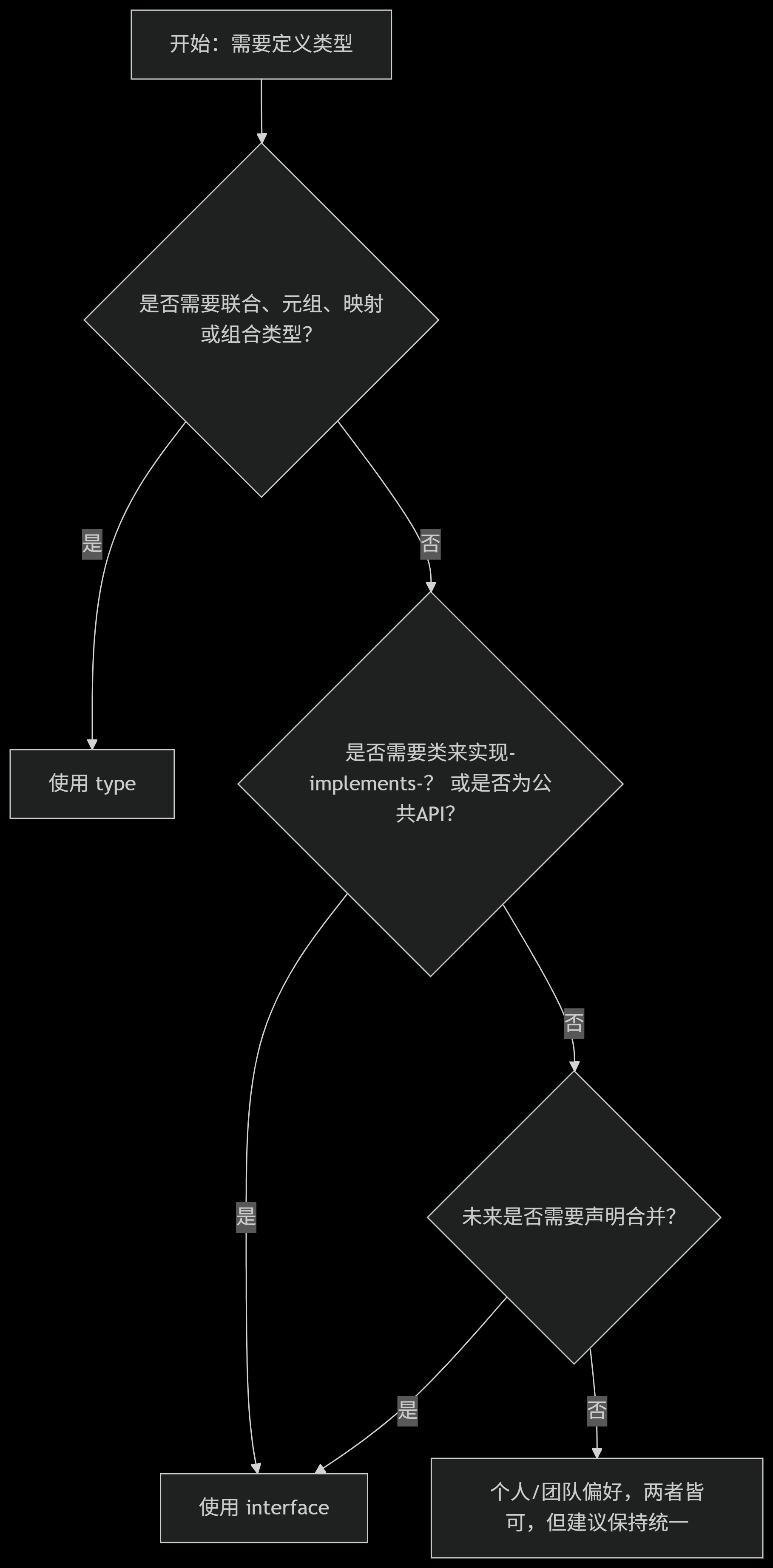类型别名(type)与接口(interface)的抉择
类型别名(type)与接口(interface)的抉择
引言:为何会有“双重选择”?
当我们初学 TypeScript,很快就会被其强大的类型系统所吸引。然而,在定义对象形状时,我们会遇到两个看似功能相似的利器:类型别名(Type Aliases) 和 接口(Interfaces)。很多初学者都会产生这样的困惑:
“它们看起来都能用来描述一个对象的结构,我到底该用哪个?它们有区别吗?”
答案是:既有重叠,更有分工。选择不当不会导致程序错误,但会影响代码的可维护性、可扩展性和团队协作的规范性。本文将深入剖析两者的异同,并提供一套清晰的决策指南,助你在未来开发中游刃有余。
一、 核心概念:它们是什么?
1. 接口(Interface)
接口的核心思想是定义一份契约(Contract),一个对外公开的承诺。它主要描述一个对象、类或函数应该是什么样子,强调其行为和公共结构。
interface 就像模块化的乐高底板。需要什么组件,直接在上面安装就可以
// 定义一份“人”的契约
interface Person {name: string;age: number;greet(): void; // 描述行为方法
}// 实现这份契约
const employee: Person = {name: "Alice",age: 30,greet() {console.log(`Hello, my name is ${this.name}`);}
};
2. 类型别名(Type)
类型别名的本质是给一个类型起一个新名字。它本身并不创造新的类型,而是提供了一个引用现有类型组合的快捷方式。它的能力更强大,可以作用于任何类型。
type 则像定制的 3D 打印乐高零件。如果想修改只能重新打印一个
// 给一个联合类型起个新名字
type ID = number | string;// 给一个复杂对象类型起个新名字
type User = {id: ID;name: string;
};
二、 功能对比:相同点与不同点
为了更直观地进行对比,我们首先用一个表格总结它们的核心特性。
功能对比表
| 特性 | 类型别名 (type) | 接口 (interface) | 胜出方 |
|---|---|---|---|
| 描述对象/函数 | ✅ | ✅ | 平手 |
| 扩展 | 通过 &(交叉类型) | 通过 extends | 平手(语法不同) |
| 合并声明 | ❌ | ✅(声明合并) | Interface |
| 联合类型 | ✅ | ❌ | Type |
| 元组类型 | ✅ | ❌(需技巧) | Type |
| 映射类型 | ✅ | ❌ | Type |
| 基本类型别名 | ✅ | ❌ | Type |
接下来,我们对表中的关键差异进行详细解读。
1. 扩展
两者都能实现扩展,但语法不同。
-
接口扩展(使用
extends):更符合面向对象思维,非常直观。interface Animal {name: string; }interface Bear extends Animal {honey: boolean; }const bear: Bear = {name: "Winnie",honey: true }; -
类型别名扩展(使用交叉类型
&):更偏向于集合操作,是类型的合并。type Animal = {name: string; };type Bear = Animal & { honey: boolean; };const bear: Bear = {name: "Winnie",honey: true };
注意:当处理同名属性的继承时,接口会报错而类型别名会将两个类型都合法
//当同名属性,类型不同会报错
interface A{fn:(value:number)=>string
}
interface B extends A{fn:(value:string)=>string
}
//交叉类型不会报错,最后这两种类型都可以选择
interface A{fn:(value:number)=>string
}
interface B{fn:(value:string)=>string
}
type c=A&B
2. 声明合并
这是两者最显著的区别,也是影响技术选型的关键因素。
-
接口:支持声明合并。你可以多次定义同一个接口,TypeScript 最终会将它们合并为一个接口。
interface Box {height: number; }interface Box {width: number; }// 最终 Box 接口为:{ height: number; width: number; } const box: Box = { height: 100, width: 200 }; // ✅ Correct应用场景:这在为第三方库(如 Window 对象)或全局类型“打补丁”(Augmentation)时非常有用。
-
类型别名:不支持声明合并。一个类型别名在同一作用域内只能被声明一次。
type Box = {height: number; };type Box = { // ❌ Error: Duplicate identifier 'Box'width: number; };
3. type特有的高级类型构造能力
类型别名能做的事情更多,尤其是在组合复杂类型时。
-
联合类型(Union Types):这是类型别名的主场。
type Status = "pending" | "success" | "error"; // 字面量联合 type Response = SuccessResponse | ErrorResponse; // 对象类型联合 -
元组类型(Tuple Types):定义固定长度和类型的数组。
type StringNumberPair = [string, number]; // 元组类型 const pair: StringNumberPair = ["hello", 42];// Interface 也可以“模拟”元组,但非常不直观,不推荐 interface TupleLike {0: string;1: number;length: 2; } -
映射类型(Mapped Types):基于旧类型创建新类型。
type Flags = {option1: boolean;option2: boolean; };// 将所有属性变为只读 type ReadonlyFlags = {readonly [K in keyof Flags]: boolean; };// 等同于 { readonly option1: boolean; readonly option2: boolean; }
三、 如何选择
经过上面的分析,我们可以得出以下决策流程:

